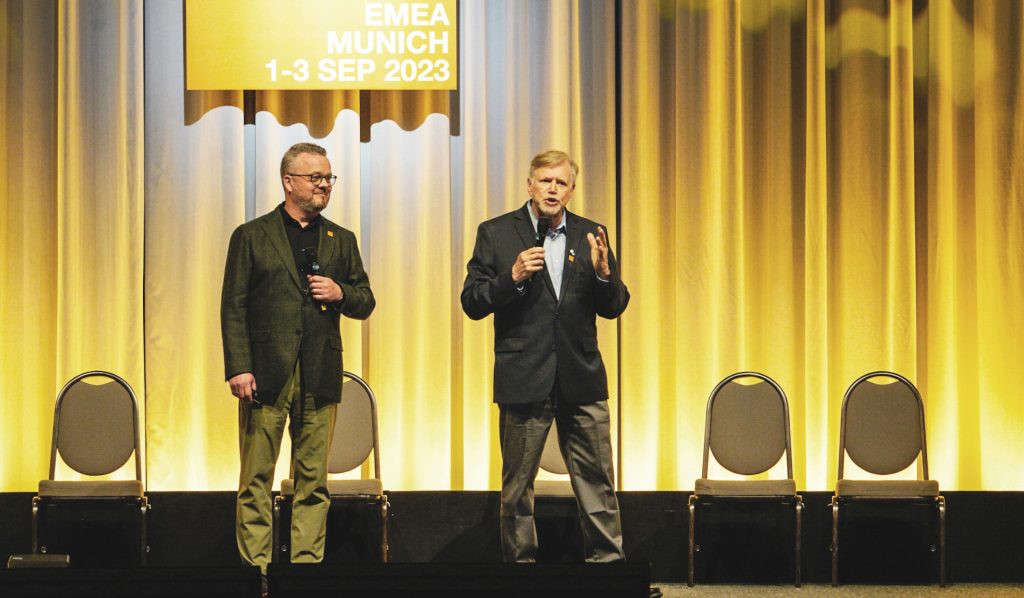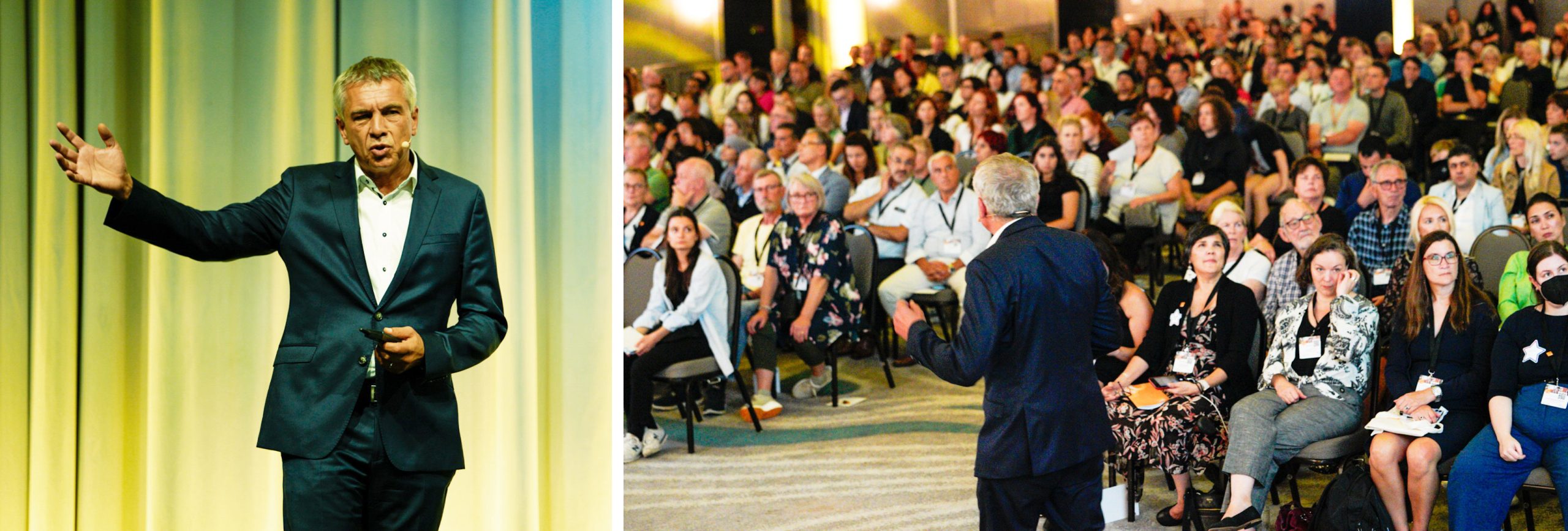This article is part of an extensive feature on the 2023 HAEi Regional Conference EMEA, published in Global Perspectives #2 2023
Across 1-3 September, the 2023 HAEi Regional Conference EMEA motivated an audience of around 650 HAE patients, caregivers, physicians/scientists, and industry representatives from 61 countries to Take Action in the knowledge that every single person in the room can make a difference. Here, we present highlights from the second of HAEi’s three Regional Conferences.
Conference Welcome
Stepping onto the stage, HAEi Chief Executive Officer and Chairman of the Board Anthony J. Castaldo and HAEi President Henrik Balle Boysen welcomed “650 of our best friends from this amazing region.”
Tony reiterated the importance of being together again, and Henrik reminded the audience that the HAEi team is dedicated to caring for everyone in the global HAE community. HAEi wakes with a heartfelt motivation to provide Member Organizations (MO) with the tools and assistance they need to gain access and reimbursement for life-saving and life-giving HAE medicines.
Tony invited the audience to remember the late, great Professor Marco Cicardi, whose pioneering work and vision led to the formation of HAEi. Tony also invoked the ‘Spirit of Budapest’ as he paid tribute to the early efforts to foster a community of physicians, scientists, patients, and caregivers. Ten years after that first meeting in Romania, HAEi has grown to 96 affiliated MOs across the globe.
Henrik outlined that the conference theme “Take Action” encapsulates the can-do attitude of the whole HAE community, something that the HAEi leadership, as fellow patients and caregivers, understands only too well.
Henrik gave an update on HAEi’s five critical areas of focus:
- Bringing HAEi closer to the countries and regions through a decentralized operational footprint
- Offering a suite of highly relevant technology-driven tools, apps and services
- Supporting the advocates of the future through a dedicated program for young people with HAE
- Delivering in-person events to bring together the community and HAE advocacy leaders
- Producing real-world data and research to demonstrate the value of HAE medicines
The two leaders turned their attention to the decentralized structure of HAEi and the mantra of “Think global, act local”. According to Tony, key to this are the accomplished Regional Patient Advocates, who were chosen because of their remarkable talent for advocacy and familiarity with the geographies they serve. Tony stressed that the RPAs are ‘always listening’ to understand the unique needs of a region like EMEA.
Sharing highlights from the upcoming program, Tony described the ACARE initiative, which accredits the best HAE treatment centers, further reinforcing the global and local link. Henrik then drew attention to the wide range of programs and services, each designed to allow every member organization to punch above their weight, achieving more for people with HAE.
Moving from tools to research, Tony explained the importance of data in helping MOs get access to and reimbursement for medicines. Tony recounted an early encounter with US policymakers: “We would go to Congress and tell them our often very moving stories. We’d make these grizzled politicians shed a tear, but nothing happened. We recognized that people react emotionally, but to truly act, they need data.”
HAEi supports and develops the data needed to give MOs a seat at the table when decisions are made about treatment. This research ranges from demonstrating the value of effective medicine to people with HAE through to baseline information on number of patients, number of attacks, and any geographical clustering. Tony noted these studies: “Put HAE at the front of the line because everyone in this room knows what it’s like to suffer from HAE attacks.”
Henrik took the opportunity to thank the pharmaceutical company sponsors, who manufacture great medicines and offer the promise of more through clinical trials; their generous support made this conference possible. Henrik thanked diamond sponsors: BioCryst and Takeda; gold sponsors: CSL Behring and Pharming; silver supporters: Astria, BioMarin, Intellia Therapeutics, Ionis, and KalVista Pharmaceuticals. The audience showed their appreciation with warm applause.
No Patient Left Behind
Taking two stairs at a time, Professor Marcus Maurer’s energy radiated from the stage. Welcoming the conference to his native Bavaria, Prof. Maurer said that the title of his presentation, No Patient Left Behind, was no mere slogan but a global rallying cry. He also said it is a universal message. Whether you are in a country with modern medicine or one currently without, Prof. Maurer made clear that this rallying cry is for you.
Prof. Maurer showed the audience a road, a patient journey with HAE. He told the audience that the road of HAE should be short, but it’s not. Too often, it is a long, winding, rough road for people, from diagnosis to treatment to complete control.
Prof. Maurer turned to the global guidelines on HAE management. His favorite recommendation was that the goal of HAE treatment is total control of the disease and to live a normal life. Marcus asked the audience: “Does that sound good? Then how do we get there?” His answer was to make sure that no one has attacks, that no one lacks control, and that no one needs to step back from living their best life.
Prof. Maurer accepted that the way to the destination can be “riddled with hurdles that you need to overcome.” He promised that through the work of HAEi and its partnership with GA2LEN (Global Allergy and Asthma Excellence Network) to create ACARE centers of leadership, the obstacles can be removed.
“The first way to overcome obstacles to complete control is providing knowledge to people living with HAE, especially youngsters, the next generation of advocacy,” Prof. Maurer told the assembled HAE community.
Prof. Maurer gave a history of ACARE. From the initial partnership with GA2LEN to the current situation with 88 centers across 35 countries. Prof. Maurer called on attendees to support ACARE’s efforts. He said: “The goal is to have at least one ACARE in every country. Thirteen new members have joined this year. Ask yourself or your clinician, why don’t you become an ACARE and do better?”
The first hurdle on the HAE journey was diagnosis. There are patients with many relations with HAE, and many who are the first in their family to have the condition; both experience delays in diagnosis. He outlined ACARE programs to educate physicians: “There’s a wonderful webinar series that is freely available to all interested, and almost 1,000 physicians have already done so, helping them to diagnose HAE from a picture of a swelling.” He also mentioned online Interact Masterclasses, bringing face-to-face preceptorships (structured guidance and support) and reaching more physicians with education on early recognition and treatment of HAE.
To educate, we must speak the same language. The fact that HAE is not just one disease can make things very difficult. As Prof. Maurer put it: “HAE comes in many types and flavors.” A vast global project called DANCE is underway to harmonize how physicians talk about angioedema and all its different subtypes and manifestations. The work of 91 experts, DANCE, is being finalized right now.
“All these projects can help target delayed diagnosis, but what of misdiagnosis?” Prof. Maurer asked. To address misdiagnosis, ACARE offers several “simple, super tools.” The first is titled: ’10 Questions That Save Lives’. Next is the tricky topic of genetic testing; Project Imagine makes free genetic testing available for anyone with suspected HAE anywhere on the planet.
Next, Prof. Maurer focused on treatment with strong words: “We now believe that androgens are dangerous in the long run, with side effects.” He accepted that for now, they are still used in Europe, the Middle East, and Africa. In order to change this, he sought data. “The project SHAERPA wants to hear from you if you ever had androgens in your treatment,” Prof. Maurer said.
Prof. Maurer said: “You can see the goal, but it’s not quite working. We lack the fine-tuning, the monitoring.” Using HAE TrackR will help you take control, and it helps clinicians see patient-reported outcome measures. “Not physician guessed, but patient-reported,” quipped Prof. Maurer. Tell your physician that you want a way to give your assessment. An angioedema control test (ACT) score is a tool that is available in 80 languages, so ask your physician, because no one knows your HAE as well as you. Prof. Maurer told the audience: “You have the information to make your physician a better treater.”
We have the data, and we have improvements, but as Prof. Maurer said, we must optimize. “We shouldn’t be happy with good. We want perfect.” Here, according to Prof. Maurer, the guideline is one of our most powerful weapons. It shows people what can be done and what the right decisions can achieve. Prof. Maurer said that the global HAE guideline is up for review, and called on physicians, patients, and caregivers in the room to sign up to be part of the next update.
Another major research project is the launch of a global angioedema registry, CARE. A big database shows us the situation with access, care, and how HAE compares to other types of angioedema. Prof. Maurer implored the audience to say yes if they were asked to donate their data. “We are building a global brain’” Prof. Maurer said.
Prof. Maurer’s final project was MENTALIST. This, he told the audience, asks physicians, industry, and policymakers to share their burning questions for future HAE research so that the answers are there to enable the right decisions to be made.
In closing, Prof. Maurer returned to No Patient Left Behind. He called on all present to make it: “easy and fast,” concluding: “This is a message of hope and of vision. We will go down that road together, and we will overcome these hurdles.”
With that stirring message and to loud applause, Prof. Maurer left the stage. The audience then split into the three tracks of youngsters, scientific, and patient/caregivers for the rest of the evening.
Find more feature articles from the 2023 HAEi Regional Conference EMEA:












